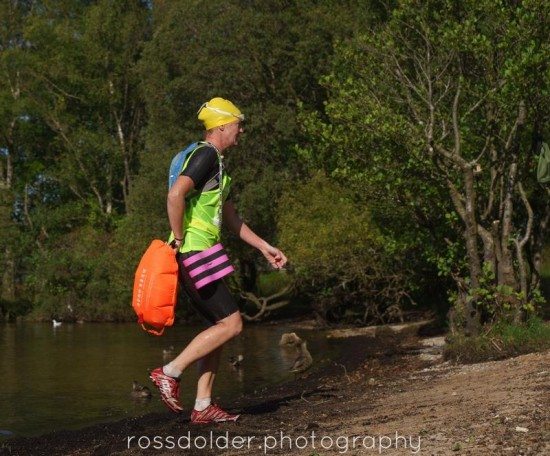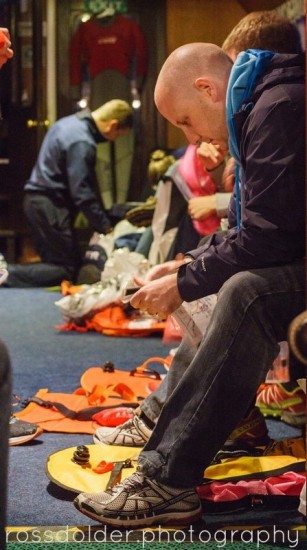On Saturday, sunshine came to Scotland and shone on 57 competitors in the UK’s first Swim Run event, Loch Lomond Inch By Inch. The race comprised 10 Swims totalling around 8km and 10 Run sections totalling around 25km. Participants had to race in pairs, although there was also a trio taking part, too.
Glasgow’s David Ogg and Ewan Mulhern were the inaugural 2015 Swim Run UK Champions. They completed the course in 5hrs 23 mins. The mixed team winners were Gemma and Chris Scott, of Derbyshire. Female team winners were East coasters Louise Smith and Penny Rother.
The original idea was conceived by my friend Nick Green (Hammer & Cycle). He mentioned it to Alan Anderson, a friend and event organiser, and Loch Lomond Inch by Swim was created.
Here, Nick gives his perspective on this unique inaugural event.
There are five of us sitting in a line on the little beach below the Craigie Fort at Balmaha on Loch Lomond. It is early morning and the loch in front of us is a smooth sheet, barely undulating with the lightest of swells.
Although we are in shade, the bright sun is hitting the water halfway across the channel to Inchcailloch and the dense trees on the far side are lit up in vivid green.
We all stare at the tree line in silence. Occasionally one of us stands in front of the small table and puts the bananas, gels, cakes and cups into neater lines. They are ordered by size, colour and flavour for easy reference. John adds some unnecessary marginal notes to his clipboard and Adam impatiently goes to stand on the furthest rock from the shore. There is nothing happening.
At least, not that we can see.
For the past hour, the competitors have been racing out as fast as they can from the far western shore of the loch towards us. They are following the chain of islands that links the two shores at this point, swimming from one to the other and running to reach the next stretch of water.
We think they must be getting close but our secluded cove has no radio reception from the boats that are tracking the swimmers.
And, then, we see them! Adam shouts back at us then starts to yell and wave his arms toward the island.

Two figures appear from the trees, hesitate for a brief moment, then plunge into the still brown water. Soon there are only two orange caps and four arms visible as they quickly close the gap to our shore.
With no other swimmers in sight, all three marshalls, two paramedics and two dogs give their full attention to the leaders before they have even reached shore.
I am one of the marshalls and I ask quickly: “Banana? Drink? Jellybeans?”
I tell them: “Leave your bag there. Go that way now.”
I ask another question: “Do you feel alright?”
This team already have a clear lead and are not in need of our help. Calmly and quickly they drop their kit, snatch some food and turn up the path that leads to Conic Hill above us. They are hardly out of sight in the trees when another pair appear on the far shore. So it continues for the next hour and a half and we become very busy.
The table of neatly ordered bananas disintegrates into one big mush of sugary calories as the exhausted shivering swimmers grab for whatever fuel they can find.
Then, with 10 minutes to go till the cut off time, the last pair pass through and quiet returns.
Our group of race ”officials” is manning the aid station on the first Swim Run event of this type in the UK. The format was devised in Sweden as a race across the multiple little islands of the Stockholm Archipelago and now attracts worldwide attention.
Although a great success in Scandinavia, Swim Run needs a particular combination of geography and climate that means it is not seen in many other places.
On a walk over Conic Hill last winter with the islands of Loch Lomond spread out below, it suddenly occurred to me that we had the perfect conditions here to do a similar race. Shortly afterwards I bumped into race promoter Alan at the Glasgow Triathlon Club Christmas dinner. He seized on the idea and immediately we were peering at the map on his phone to trace out routes. Now, to Alan’s immense credit, it has actually happened.
Back on the beach, we are trying to put things in some sort of order before the teams return from the hill. Most have left behind the drybags that they tow behind in the water with their kit inside. All have kept their wetsuits on for the run, which is worrying because the sun is now fully on the upper slopes of the hill and it is hard to imagine how warm that must be.
Many already have painful bleeding chafe marks on their necks where the suits rub.
The first teams begin to arrive back at the beach and we are immediately into the busy routine of recording times and replenishing supplies on the table. All are clearly more tired now and gulp down the flat coke and sports drink that we put out.
The footbridge spanning the beach has become a grandstand for spectators shouting encouragement to the competitors below.
Loaded with bags and swim kit they are soon off again with 5k to run up the loch shore before they re-enter the water and begin the return leg to the western shore. The dense forest gives little impression of where each team stands in the overall race but as time goes on they care less and less about that and only talk about completing within the time limit.
As the field passes through we are visited briefly by the safety boats and jet skis and the radios chatter away noisily, but soon it goes quiet again. The outlying marshalls come in from the hill and help us transport our gear back along the shore path to the road. Everything is now coated in a wet, sticky layer of sports drink that I expect will dry out like glue.
We have nothing left to do. Like a travelling circus the race has moved on to another part of the loch. As a spectacle and a sports event it has worked brilliantly and I have never enjoyed marshalling as much. Certainly, the perfect weather has been a factor but it is a unique, proper adventure that deserves to be repeated. I might even enter it myself.
See Swim Run UK.
Many thanks to Ross Dolder for letting me use his photos. You can contact him.











